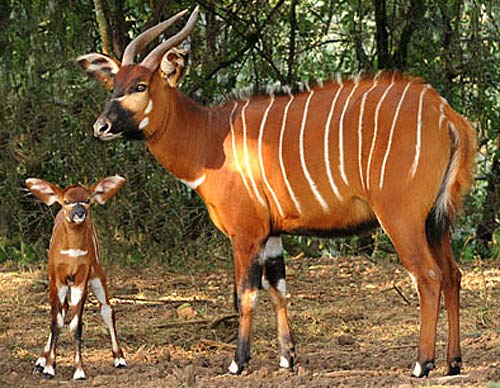Two mountain bongos are delivered into the timberland on the inclines of Mount Kenya.
Two probably won't seem to be much yet the absolute wild populace of these pronghorn is under 100.
The program is being controlled by the Mount Kenya Untamed life Conservancy which breeds these lovely animals in imprisonment and afterward delivers them into their normal living space.
They've once again introduced a sum of 10 bongos lately.
"So we have once again introduced them again inside the Mt. Kenya backwoods which we know is a previous bongo range," says Dr Robert Aruho, top of the mountain bongo program.
"The bongos used to reside there and presently today we saw another event where these creatures again have been sent back to their wild home in their previous reach," he adds.
Mountain bongos were once normal in Kenya, particularly in the Mt. Kenya timberland yet there are currently scarcely any that they're delegated "basically jeopardized" by the IUCN (Worldwide Association for Protection of Nature).
"Thus, poaching for bushmeat, then, at that point, live exchange for the people who needed to keep mountain bongos and afterward additionally hunting in view of their prizes, skin and the horns. That carried the quantities of bongos to go so low," says Aruho.
"As the Bongo was all the while battling, there was a rinderpest (cows plague) episode in 1980 here in Kenya which killed a large portion of the ungulates and the bongo likewise was not saved. Also, that crashed the populace to under 100 people and its recuperation has been so sluggishly in the wild and that is the reason now the main conceivable course for recuperation was to raise the mountain bongo and afterward re-wild them," he adds.
As per Aruho, the mountain bongo's endurance right at home is critical for balance in the biological system.
He trusts that the presence of this "leader species" will eventually safeguard their woodland territory.
At Mt Kenya Natural life Conservancy the bongos are 'prepared' to make due in nature.
Toward the starting they are given up to 75% of their eating routine which then, at that point, tightens to half and afterward 30%, as they figure out how to search for food all alone.
Whenever they are delivered into the wild, they ought to have the option to battle for them and even fend off hunters.
The conservancy intends to deliver 50 mountain bongos by 2025.
The Mawingu Mountain Bongo Safe-haven is fenced however there are plans to eliminate the wall once a specific number of creatures is reached.

Post a Comment